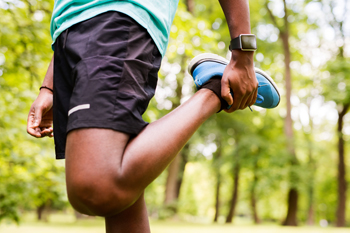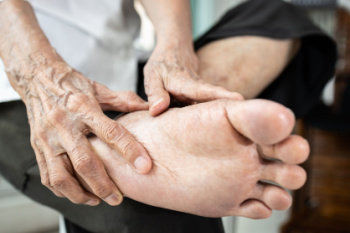Connect With Us
Blog

Incorporating foot stretches into your post-run routine offers a multitude of benefits, helping your feet recover from the demands of running while reducing the risk of future injury. Toe curls, where you curl your toes downward and then upward, help strengthen the muscles in your feet and improve flexibility. Ankle rotations, performed by gently rotating your ankles in clockwise and counterclockwise motions, enhance ankle mobility and reduce stiffness. Additionally, plantar fascia stretches, achieved by gently pulling your toes towards you to stretch the arch of your foot, alleviate tension in the plantar fascia, and help prevent conditions like plantar fasciitis. Calf stretches, targeting the muscles in the lower leg, improve range of motion and prevent tightness during running. Finally, Achilles tendon stretches, where you lean against a wall with one foot back and gently press the heel towards the ground, increase flexibility and reduce strain on the Achilles tendon. By incorporating these stretches into your post-run routine, you can optimize performance, prevent injuries, and promote overall foot health. If you have endured a foot injury from running, it is suggested that you visit a podiatrist who can offer you appropriate treatment options, in addition to suggesting foot stretches that are best for you.
Stretching the feet is a great way to prevent injuries. If you have any concerns with your feet consult with one of our podiatrists from Podiatry Care Specialists. Our doctors will assess your condition and provide you with quality foot and ankle treatment.
Stretching the Feet
Stretching the muscles in the foot is an important part in any physical activity. Feet that are tight can lead to less flexibility and make you more prone to injury. One of the most common forms of foot pain, plantar fasciitis, can be stretched out to help ease the pain. Stretching can not only ease pain from plantar fasciitis but also prevent it as well. However, it is important to see a podiatrist first if stretching is right for you. Podiatrists can also recommend other ways to stretch your feet. Once you know whether stretching is right for you, here are some excellent stretches you can do.
- Using a foam roller or any cylindrical object (a water bottle or soda can will do), roll the object under your foot back and forth. You should also exert pressure on the object. Be sure to do this to both feet for a minute. Do this exercise three times each.
- Similar to the previous one, take a ball, such as a tennis ball, and roll it under your foot while seated and exert pressure on it.
- Grab a resistance band or towel and take a seat. If you are using a towel, fold it length wise. Next put either one between the ball of your foot and heel and pull with both hands on each side towards you. Hold this for 15 seconds and then switch feet. Do this three times for each foot.
- Finally hold your big toe while crossing one leg over the other. Pull the toe towards you and hold for 15 seconds. Once again do this three times per foot.
It is best to go easy when first stretching your foot and work your way up. If your foot starts hurting, stop exercising and ice and rest the foot. It is advised to then see a podiatrist for help.
If you have any questions, please feel free to contact our offices located in West Chester, and Broomall, PA . We offer the newest diagnostic and treatment technologies for all your foot care needs.

Rheumatoid arthritis, or RA, is an autoimmune disorder causing inflammation in joints, often leading to pain, stiffness, and swelling. It can affect any joint in the body, including those in the feet and ankles. Symptoms include joint tenderness, warmth, and deformities. In the feet, RA can result in bunions, hammertoes, and collapsed arches, impacting mobility, and causing discomfort. Long-term effects may include joint damage, disability, and reduced quality of life. RA commonly affects women more than men, typically starting between ages 30 and 60, but can occur at any age. While there is no cure for RA, management focuses on alleviating symptoms and preventing joint damage. If you have RA, it is strongly suggested that you schedule an appointment with a podiatrist who can provide specialized care for foot and ankle issues associated with RA and enhance your overall quality of life.
Because RA affects more than just your joints, including the joints in your feet and ankles, it is important to seek early diagnosis from your podiatrist if you feel like the pain in your feet might be caused by RA. For more information, contact one of our podiatrists of Podiatry Care Specialists. Our doctors will assist you with all of your podiatric concerns.
What Is Rheumatoid Arthritis?
Rheumatoid Arthritis (RA) is an autoimmune disorder in which the body’s own immune system attacks the membranes surrounding the joints. Inflammation of the lining and eventually the destruction of the joint’s cartilage and bone occur, causing severe pain and immobility.
Rheumatoid Arthritis of the Feet
Although RA usually attacks multiple bones and joints throughout the entire body, almost 90 percent of cases result in pain in the foot or ankle area.
Symptoms
- Swelling and pain in the feet
- Stiffness in the feet
- Pain on the ball or sole of feet
- Joint shift and deformation
Diagnosis
Quick diagnosis of RA in the feet is important so that the podiatrist can treat the area effectively. Your doctor will ask you about your medical history, occupation, and lifestyle to determine the origin of the condition. Rheumatoid Factor tests help to determine if someone is affected by the disease.
If you have any questions please feel free to contact our offices located in West Chester, and Broomall, PA . We offer the newest diagnostic and treatment technologies for all your foot and ankle needs.

A hammertoe is a foot deformity where one or more toes bend abnormally at the middle joint, resembling a hammer. Symptoms can include pain, discomfort, corns, calluses, and difficulty wearing shoes. Common causes include wearing tight shoes, muscle imbalance, arthritis, and genetic predisposition. Diagnosis involves physical examination and sometimes imaging tests like X-rays. Treatment options for hammertoe depend on the severity and may include wearing roomier shoes and custom-made orthotic devices, performing exercises to stretch and strengthen toe muscles, and in severe cases, undergoing surgery to correct the toe's alignment. Living with hammertoe requires wearing proper footwear, avoiding high heels and narrow shoes, and doing regular foot inspections. Adapting lifestyle habits, such as maintaining a healthy weight and exercising regularly, can also help to alleviate symptoms and prevent the worsening of the condition. If you have a hammertoe and it is causing discomfort, it is suggested that you schedule an appointment with a podiatrist for effective management options.
Hammertoe
Hammertoes can be a painful condition to live with. For more information, contact one of our podiatrists from Podiatry Care Specialists. Our doctors will answer any of your foot- and ankle-related questions.
Hammertoe is a foot deformity that affects the joints of the second, third, fourth, or fifth toes of your feet. It is a painful foot condition in which these toes curl and arch up, which can often lead to pain when wearing footwear.
Symptoms
- Pain in the affected toes
- Development of corns or calluses due to friction
- Inflammation
- Redness
- Contracture of the toes
Causes
Genetics – People who are genetically predisposed to hammertoe are often more susceptible
Arthritis – Because arthritis affects the joints in your toes, further deformities stemming from arthritis can occur
Trauma – Direct trauma to the toes could potentially lead to hammertoe
Ill-fitting shoes – Undue pressure on the front of the toes from ill-fitting shoes can potentially lead to the development of hammertoe
Treatment
Orthotics – Custom made inserts can be used to help relieve pressure placed on the toes and therefore relieve some of the pain associated with it
Medications – Oral medications such as anti-inflammatories or NSAIDs could be used to treat the pain and inflammation hammertoes causes. Injections of corticosteroids are also sometimes used
Surgery – In more severe cases where the hammertoes have become more rigid, foot surgery is a potential option
If you have any questions please contact our offices located in West Chester, and Broomall, PA . We offer the newest diagnostic and treatment technologies for all your foot and ankle needs.

